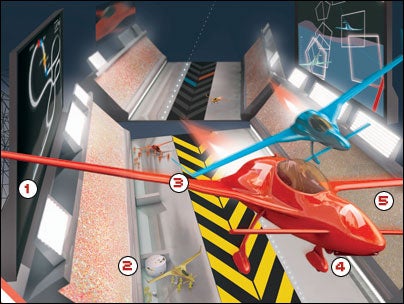AFTER DECADES OF PUTTING MONKEYS in space, landing men on the moon, and taking high school science projects into orbit, rocket scientists have finally turned their attention to something practical: spectator sports. This fall, after five years of prototype test flights, the first Mark-1 X-Racer rocket plane will take to the skies as the fire-breathing workhorse of the new Rocket Racing League, which promises to deliver something between NASCAR and the pod-racing scenes in Star Wars: Episode I (see details below). The ultimate goal, says league cofounder Peter Diamandis, is a competition that will grow from a domestic six-event season in 2007 to a broader tour, with a season-long points competition and races taking place all over the world. Before that happens, though, scientists will have to perfect a way to simultaneously look up and drink beer.
1. The RACECOURSE
will be a winding five-mile loop that will look something like a three-dimensional Formula-1 circuit. While most of the racing will take place at around 1,000 feet off the ground, the pilots will have to make low-altitude plunges to about 500 feet at certain points during each lap, including spectator-friendly passes near the grandstands.
2.
The pilots will make four to six PIT STOPS during each 90-minute race. Eight-person crews will pump a mix of liquid oxygen and kerosene and change the lithium batteries that power the electronics. This is one area where X-Racers will be markedly slower than their automotive counterparts, as each stop will take about eight minutes, compared with 14 seconds in NASCAR.
3.
To create the X-RACERS, engineers converted an aircraft called the Velocity SE, an experimental plane with superb gliding capabilitiesracers will glide for long stretches between rocket burnsand a frame that can handle the 12 G-forces as the planes accelerate. Though the rockets will be capable of going five times faster, speeds will be kept safely around 300 miles per hour.
4.
Five CAMERAS will be mounted on each plane, offering multiple views of the action, including one camera that will be trained on the pilot. Advanced instrumentation, drawn from technology used in fighter jets and NASA spacecraft, will include heads-up displays that show the pilots three-dimensional representations of the racecourse.
5.
An array of multimedia devices will keep the SPECTATORS involved in the action. The audience will be surrounded by six 50-foot screens, with geometric rings superimposed over live video to highlight the flight path. Handheld units will display the planes’ locations on the course, real-time standings, and a selection of video feeds from the cameras on the X-Racers.


